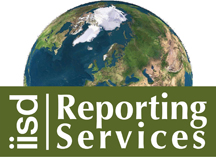News * Abou us * the ENB team * DONATE * Activities * Search * IISD RS home * IISD.org * RSS * What is RSS? * Links |
|
MEA Bulletin
3 May 2006 MAINSTREAMING MEAS INTO THE MDGS By Bakary Kante, Director, UNEP/DEC Poverty is usually defined in financial terms. Yet a person with a dollar a day living in a degraded environment may be worse off than a person without money who lives on unspoiled land. The answer to this dilemma is not to stop efforts to increase the incomes of poor people-there are still some things only money can buy. The answer must lie in a consistent focus on the ecosystem services the environment provides to poor people for the expansion of their capabilities to lead the life they have reason to value. The Millennium Ecosystem Assessment found that two-thirds of the services that ecosystems provide to humankind are in decline, many of them, such as global fisheries, have been weakened beyond repair. But while these ecosystem services are already in a state of stress, the eradication of hunger and poverty requires significant increases in the supply of the very same services. What are the appropriate policy responses to this dilemma? Eradicating poverty and disease are of course of the highest priority. But they can’t be de-linked from the natural environment in which human beings live. In other words you cannot address the MDGs without also thinking about environmental implications. Environment underpins all the MDGs. It must be mainstreamed into policies that will have a chance of eradicating extreme poverty or disease. Therefore it is critical to recognize the equal importance of environmental sustainability as one of the supporting pillars of the MDGs and acknowledge that MDG7 cannot be achieved in isolation, or done sequentially before or after any other MDG. This thinking needs to be mainstreamed not only into development policy but also into the environmental side of the equation. One way to facilitate this is through active engagement of MEAs in the broader MDG process, and vice versa. MEAs focus on specific, ground-truth-based activities, but more critically, MEAs are legally binding instruments capable of mobilizing effective social, political and economic action and change. Already many MEAs have taken up the issues of the MDGs into their work and some of the above actions. Concerning MDG 1 (combating poverty and hunger), the role of the United Nations Convention to Combat Desertification (UNCCD) is of particular importance. The UNCCD sets out as one of its primary objectives socio-economic aims such “as achieving food security and sustainable development and management of agricultural, livestock-rearing, forestry and multipurpose activities” and integrating “strategies for poverty eradication into efforts to combat desertification and mitigate the effects of drought.” At the fifth meeting of the Joint Liaison Group, members recognized that the three Rio Conventions had the common objectives of contributing to sustainable development and to both the JPOI and the MDGs. Individually, the Rio Conventions have also made specific references to the role they can play in assisting the implementation of the MDGs. For example, the UN Framework Convention on Climate Change (UNFCCC) COP-9 decisions creating the Special Climate Fund and the Least-Developed Countries Fund took note of the fact that these two funds contribute “to the achievement of the World Summit on Sustainable Development (WSSD) and the MDGs, and contribute to the integration of climate change considerations into development activities.” The Convention on Biological Diversity (CBD) has been one of the most proactive conventions in its work on Inter-linkages and on its contribution to the MDGs. In Decision VII/32 of CBD COP-7, the Parties recognized the links between MDG 1 (Combating poverty and hunger), MDG 6 (combating diseases) and MDG 7 and the dependence “on the effective conservation of biological diversity, the sustainable use of its components, and the fair and equitable sharing of the benefits arising out of the utilization of genetic resources.” Global fisheries are also an important area in the fight to eradicate extreme poverty and hunger. The FAO estimates that fish make up 16 percent of the world population’s protein intake and provide employment for 35 million full- and part-time fishers, with more than two thirds of both total catch and employment coming from marine capture fisheries. However, global fisheries are widely known to be near collapse. The UN Convention on the Law of the Sea’s Implementing Agreement on the Conservation and Management of Straddling Fish Stocks and Highly Migratory Fish is a key agreement for the sustainable use of fish stocks such as cod and tuna and many other species that tend to migrate between various zones of national sovereignty (i.e. the Exclusive Economic Zone - EEZ) or are transboundary by nature. In addition, other organizations such as the FAO and numerous regional fishery agreements are playing key roles in ensuring the sustainability of global and regional fisheries. Lastly, the Ramsar Convention, the World Heritage Convention, the Convention on International Trade in Endangered Species (CITES) and the Convention on Migratory Species (CMS) are also working in collaboration with the CBD on significantly reducing biodiversity loss by 2010, as well as on other activities related to the MDGs. At present, the MDGs have no concrete governance framework for implementation, and this represents a major hurdle for creating effective economic, technological, social and legal responses to achieving the goals within the set timeframe. In this context multilateral environmental agreements could provide a concrete medium for MDG action. Although challenging, we must succeed in this task because the lessons are already clear: poverty alleviation strategies that do not integrate environmental concerns are unlikely to succeed. Two or three dollars a day will not pay for clean water, food, shelter and human growth. Yet where the environment provides water, food and shelter, even a dollar a day may represent true wealth. |

